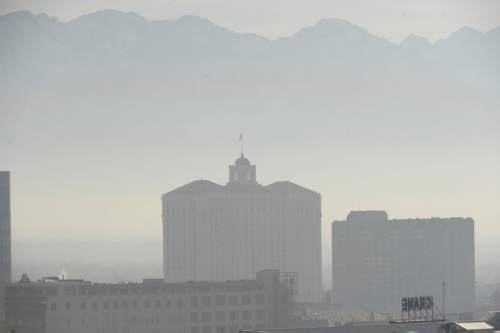This is an archived article that was published on sltrib.com in 2015, and information in the article may be outdated. It is provided only for personal research purposes and may not be reprinted.
Utahns with heart disease have one more reason to stay inside on bad-air days this winter: Pollution can literally give you a heart attack.
A new study at the Intermountain Medical Center Heart Institute found that the risk of the most serious kind of heart attack rises after the level of PM2.5 (fine particulate) pollution reaches 25 micrograms per cubic meter of air. The Utah Department of Environmental Quality considers that in the yellow, or "moderate," range of air pollution.
Such pollution is comprised of fine particles of metals, allergens, organic chemicals, soot and dirt, each measuring about 1/20th the width of a human hair.
For every 10 micrograms above 25 the PM2.5 rate reaches, the risk of a serious heart attack rises by 15 percent, said Kent Meredith, an Intermountain Medical Center cardiologist who reported on the research at the American Heart Association scientific session in Orlando, Fla., on Sunday.
The monitoring station at Hawthorne Elementary in Salt Lake City recorded only 13 days of PM2.5 pollution above 25 micrograms last winter, but 34 days in the noxious winter of 2013-14 and 29 days the winter before that. November sees an occasional bad-air day, but the worst pollution strikes in December, January and February each year.
The findings "pile on" a body of research that links bad air to heart problems, but it zeros in on the kind of heart attack those with heart disease are most likely to suffer during bouts of bad air: deadly.
Such heart attacks are called STEMI, for ST-segment elevation myocardial infarction. It's when a coronary artery is totally blocked and a large part of the heart muscle cannot get oxygen.
"These are the types of heart attacks," Meredith said, "where you literally have minutes to get to the hospital and get those arteries opened."
The research involved studying the heart attacks of more than 16,000 Wasatch Front patients at LDS Hospital and Intermountain Medical Center between 1993 and 2014. The records are in a database kept by Intermountain's Cardiac Catheterization Laboratory.
The research, however, found a weak correlation between high air pollution and non-STEMI heart attacks or unstable angina, Meredith said.
People with heart disease are most vulnerable because they have plaque in their artery walls, which becomes inflamed when they breathe polluted air, Meredith said. The plaque becomes unstable, swells and splits, blocking an artery.
"You most often don't get a warning for these," he said.
Cardiologist John Ryan at the University of Utah said that breathing in particles also can aggravate asthma or reactive airway disease, which decreases oxygen level and puts a strain on the heart.
"These are important findings that are additive to what we've found previously on heart disease and air quality," Ryan said Friday. "It's sobering to think a bad-air day could be the cause for a heart attack."
Many North Americans are unaware they have heart disease, so it's important to manage the risk factors, including controlling one's weight, cholesterol and blood pressure, and getting daily exercise, Ryan said.
And on bad-air days, those with heart disease should stay inside, he said. "Families need to know this, too."
C. Arden Pope, a Brigham Young University epidemiologist involved in the new study, said he used state pollution-monitoring-station data for Utah, Salt Lake and Weber valleys.
That was compared against the heart attacks of 16,314 patients living in those areas.
The research affirmed earlier findings. But, he said, "in this particular case, we have a lot more data over a lot longer period of time."









